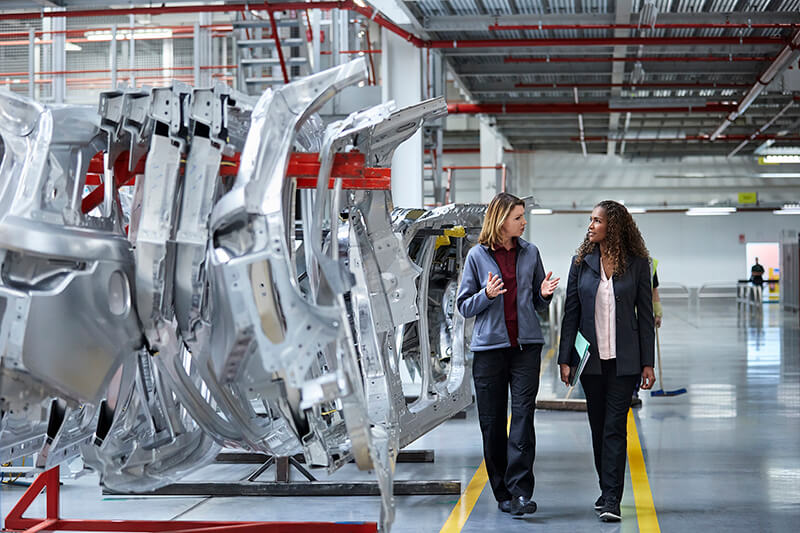June 15, 2020
New technique for polymer manufacturing with reduced solvents aimed at vehicle, packaging production
 Purdue University innovators hope new technology provides a more business-friendly option to utilize sustainable cellulose nanomaterials for use in vehicles, food packaging and other manufactured items. (Stock image)
Download image
Purdue University innovators hope new technology provides a more business-friendly option to utilize sustainable cellulose nanomaterials for use in vehicles, food packaging and other manufactured items. (Stock image)
Download image
WEST LAFAYETTE, Ind. – A team of Purdue University innovators hopes its new technology provides a more business-friendly option to utilize sustainable cellulose nanomaterials for use in vehicles, food packaging and other manufactured items.
The Purdue team developed a new way for manufacturers to use nanocellulose – a green nanomaterial derived from natural sources such as plant matter. Normally to process nanocellulose, solvents or other dispersants are usually added to the mixture to improve the material’s dispersion in polymers.
“These methods can be very expensive for manufacturers, who must add additional processes and machinery to comply with emission standards that may be impacted by the use of the solvents,” said Jeffrey Youngblood, a professor of materials engineering in Purdue’s College of Engineering.
The Purdue innovators created a method that involves mixing the nanocellulose in additives for the polymer material, such as plasticizer, and then compounding that mixture into the polymer instead of directly mixing them.
This technique could be applicable to a wide variety of polymers, including nylons used in the automotive industry and polylactic acid and ethylene vinyl alcohol copolymer used in food packaging. It enables nanocellulose to be easily extruded or injection molded into useful products with better properties that are more sustainable.
“We created a way to use the additives that are normally in polymers as the ‘solvent’ to disperse the nanocellulose during melt processing,” Youngblood said. “In this way, you still have increased properties, but without the pieces of the manufacturing process that require additional emissions-lowering components. This makes the process of using the nanocellulose, which is biodegradable, more sustainable as well.”
Youngblood said the main advantages to the Purdue technique for large-scale polymer production are:
- Solvent-free compounding of nanocellulose into polymers.
- Homogenous mixture of hydrophilic nanocellulose and hydrophobic polymer.
The innovators have worked with the Purdue Research Foundation Office of Technology Commercialization to patent the technology. They are looking for additional partners and those interested in licensing the technology. For more information, contact Dipak Narula of OTC at dnarula@prf.org and reference track code 68912.
About Purdue Research Foundation Office of Technology Commercialization
The Purdue Research Foundation Office of Technology Commercialization operates one of the most comprehensive technology transfer programs among leading research universities in the U.S. Services provided by this office support the economic development initiatives of Purdue University and benefit the university's academic activities through commercializing, licensing and protecting Purdue intellectual property. The office recently moved into the Convergence Center for Innovation and Collaboration in Discovery Park District, adjacent to the Purdue campus. In fiscal year 2019, the office reported 136 deals finalized with 231 technologies signed, 380 disclosures received and 141 issued U.S. patents. The office is managed by the Purdue Research Foundation, which received the 2019 Innovation and Economic Prosperity Universities Award for Place from the Association of Public and Land-grant Universities. In 2020, IPWatchdog Institute ranked Purdue third nationally in startup creation and in the top 20 for patents. The Purdue Research Foundation is a private, nonprofit foundation created to advance the mission of Purdue University. Contact otcip@prf.org for more information.
About Purdue University
Purdue University is a top public research institution developing practical solutions to today’s toughest challenges. Ranked the No. 6 Most Innovative University in the United States by U.S. News & World Report, Purdue delivers world-changing research and out-of-this-world discovery. Committed to hands-on and online, real-world learning, Purdue offers a transformative education to all. Committed to affordability and accessibility, Purdue has frozen tuition and most fees at 2012-13 levels, enabling more students than ever to graduate debt-free. See how Purdue never stops in the persistent pursuit of the next giant leap at purdue.edu.
Writer: Chris Adam, 765-588-3341, cladam@prf.org
Source: Jeffrey Youngblood, jpyoungb@purdue.edu

